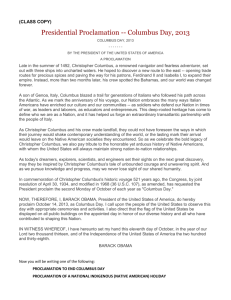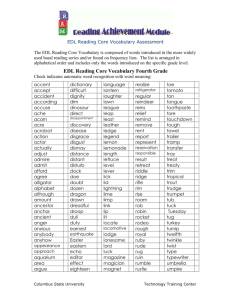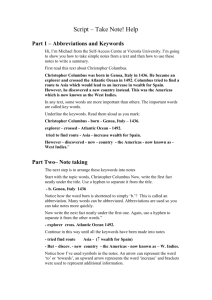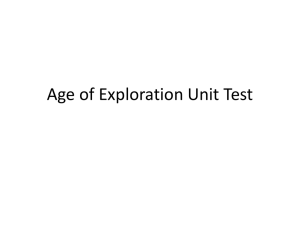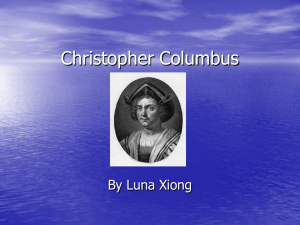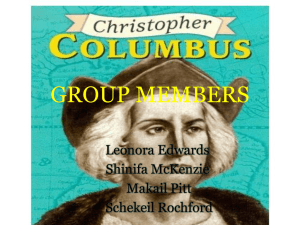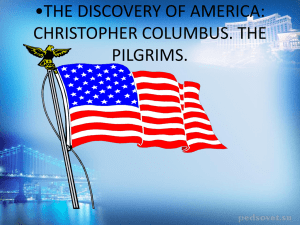Bio-facts for New World Explorers
advertisement
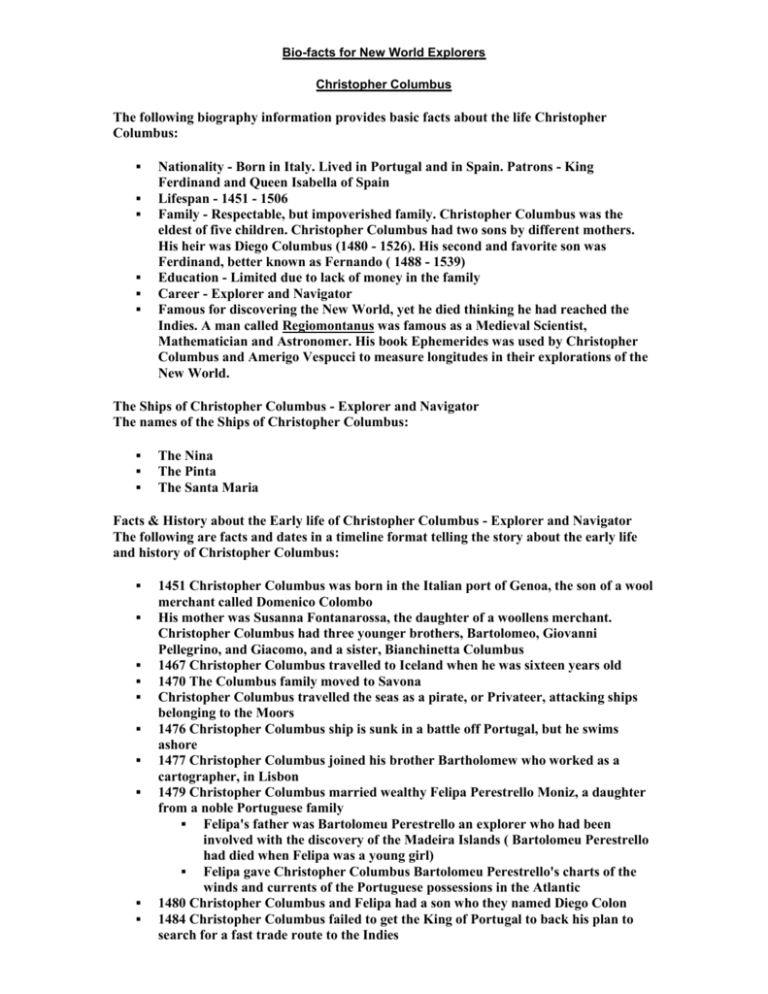
Bio-facts for New World Explorers Christopher Columbus The following biography information provides basic facts about the life Christopher Columbus: Nationality - Born in Italy. Lived in Portugal and in Spain. Patrons - King Ferdinand and Queen Isabella of Spain Lifespan - 1451 - 1506 Family - Respectable, but impoverished family. Christopher Columbus was the eldest of five children. Christopher Columbus had two sons by different mothers. His heir was Diego Columbus (1480 - 1526). His second and favorite son was Ferdinand, better known as Fernando ( 1488 - 1539) Education - Limited due to lack of money in the family Career - Explorer and Navigator Famous for discovering the New World, yet he died thinking he had reached the Indies. A man called Regiomontanus was famous as a Medieval Scientist, Mathematician and Astronomer. His book Ephemerides was used by Christopher Columbus and Amerigo Vespucci to measure longitudes in their explorations of the New World. The Ships of Christopher Columbus - Explorer and Navigator The names of the Ships of Christopher Columbus: The Nina The Pinta The Santa Maria Facts & History about the Early life of Christopher Columbus - Explorer and Navigator The following are facts and dates in a timeline format telling the story about the early life and history of Christopher Columbus: 1451 Christopher Columbus was born in the Italian port of Genoa, the son of a wool merchant called Domenico Colombo His mother was Susanna Fontanarossa, the daughter of a woollens merchant. Christopher Columbus had three younger brothers, Bartolomeo, Giovanni Pellegrino, and Giacomo, and a sister, Bianchinetta Columbus 1467 Christopher Columbus travelled to Iceland when he was sixteen years old 1470 The Columbus family moved to Savona Christopher Columbus travelled the seas as a pirate, or Privateer, attacking ships belonging to the Moors 1476 Christopher Columbus ship is sunk in a battle off Portugal, but he swims ashore 1477 Christopher Columbus joined his brother Bartholomew who worked as a cartographer, in Lisbon 1479 Christopher Columbus married wealthy Felipa Perestrello Moniz, a daughter from a noble Portuguese family Felipa's father was Bartolomeu Perestrello an explorer who had been involved with the discovery of the Madeira Islands ( Bartolomeu Perestrello had died when Felipa was a young girl) Felipa gave Christopher Columbus Bartolomeu Perestrello's charts of the winds and currents of the Portuguese possessions in the Atlantic 1480 Christopher Columbus and Felipa had a son who they named Diego Colon 1484 Christopher Columbus failed to get the King of Portugal to back his plan to search for a fast trade route to the Indies 1485 Christopher Columbus wife Felipa dies of consumption 1485 Christopher Columbus moves to Cadiz in Spain opening another shop supplying maps and charts 1486 Columbus begins his relationship with Dona Beatriz Enriquez de Arana, a lady of a noble family from Cordova in Spain 1486 Columbus first petitions his plans to the Spanish court but is refused 1487 He was in the service of the Duke of Medina Celi, Don Luis de la Cerda 1487 Columbus submits his plans to King Henry VII of England and King Charles VIII of France but they both decline his proposals 1488 His second and favorite son Ferdinand, better known as Fernando ( 1488 1539) was born. His mother was Dona Beatriz Enriquez 1491 Columbus again appealed to King Ferdinand taking his son Diego with him but he was again refused 1491 A priest called Father Perez interceded on behalf of Columbus and pleaded with Queen Isabella to fund Columbus who, if he succeed would be able to convert heathen races to Christianity 1492 King Ferdinand and Queen Isabella of Spain finally give Christopher Columbus the money and ships Both the sons of Christopher Columbus served as pages to Prince Juan, the son of the King Ferdinand and Queen Isabella 1492 August Columbus leaves Palos, Spain in search of the Indies Timeline, Facts & History about the 1492 voyage of Christopher Columbus to the New World Christopher Columbus ship was called the Santa Maria. It was completely decked and carried the flag of Columbus as admiral. His son, Fernando accompanied Columbus The other two ships, the Pinta, and the Nina, were undecked caravels with cabins and forecastles Martin Alonso Pinzon commanded the Pinta and his brother, Vicente Yanez Pinzon commanded the Nina Christopher Columbus three ships carried 120 men 1492 September 8 - The Voyage of Christopher Columbus began 1492 September 15 The ships touched at the Canaries the conditions were favorable 1492 September 20 The Sargasso Sea - the conditions change. Columbus kept two log books to deceive the crew as to the real length of the voyage 1492 September 23 The Crew Members Become Disgruntled 1492 October 7 False Landfall is spotted 1492 October 11 There is near Mutiny from the crew 1492 October 12 Land was seen plainly by one of the Pinta's crew 1492 October 12 Columbus lands on Watling's Island in the Bahamas, West Indies. The discoverers named the island San Salvador. Columbus believes that he has reached the passage to India and China 1492 October 28 Cuba 1492 December 5 the Santa Maria sinks off the cost of Hispaniola Christopher Columbus establishes the first Spanish settlement in the New World 1492 January 16 Christopher Columbus starts the return journey home to Spain Timeline, Facts & History about the Later life of Christopher Columbus The following are facts and dates in a timeline format telling the story about the later life and history of Christopher Columbus: 1493 Christopher Columbus arrives at Palos in Spain on 15 March, 1493 He brings the news to Europe of the New World 1493, 25 September The Second voyage of Christopher Columbus with 16 ships from Cadiz, carrying about 1500 men including Juan Ponce de Leon Columbus explores Hispaniola (Jamaica) and encounters the hostile Carib and Arawak native indians Columbus establishes a Spanish settlement in Haiti and searches for gold 1494 September 29 Christopher Columbus returns to Spain 1498 May 30 The Third voyage of Christopher Columbus from Seville, Spain, with six ships 31 July 1498 Christopher Columbus arrived at the Cape Verde Islands, near Trinidad Columbus crossed over to the mainland where he discovered pearls Christopher Columbus was the first European to land in South America News spreads to Spain about problems in the Spanish settlements. Columbus is heavily criticised for its handling A visita was ordered - it was a much dreaded measure. The visitador chosen to investigate was Francisco de Bobadilla 24 August, 1500 Bobadilla landed at Santo Domingo Francisco de Bobadilla believed that Columbus and his brothers considered themselves rulers of the new country. He ordered their imprisonment, where they were harshly held in irons 1500 October Christopher Columbus and his brothers are sent home in chains Royalty, nobility and the Spanish people were horrified at the injustices which ad been heaped on Christopher Columbus and all previous property confiscated and rank was restored to Christopher Columbus Christopher Columbus proposed yet another voyage of discovery 1502 Fourth and final voyage of Christopher Columbus leaves from Cadiz, Spain, with four ships 1504 7th November - Christopher Columbus returns to Spain 1506, May 20 Christopher Columbus dies at the Spanish court at Valladolid Bio-facts for New World Explorers Francisco Vasquez de Coronado The following biography information provides basic facts about the life Francisco Vasquez de Coronado: Nationality - Spanish Lifespan - 1510 - 1554 Family - Noble Spanish family Education - Well educated befitting the status of his family Career - Spanish Conquistador and Explorer Famous as : the first European to explore the Southwest of North America in Arizona and New Mexico. He searched for the mythical Seven Cities of Gold - El Dorado The following are additional facts and a timeline about the life and history of Francisco Vasquez de Coronado: 1510: Francisco Vazquez de Coronado was born in Salamanca, Spain 1535: Coronado went to New Spain (Mexico) with Antonio de Mendoza (1490–1552) the Spanish Viceroy 1537: Coronado had married the wealthy daughter of the colonial treasurer. They had eight children. 1538: Francisco Vazquez de Coronado was made governor of Nueva Galicia 1539: Viceroy Antonio de Mendoza is told of the Seven Cities of gold. The myth is given credence by a Franciscan friar named Marcos de Niza (1495– 1558) who tells of a gleaming city called Cibola that local Indians described as only the smallest of the seven which holds more gold than the Incas 1539: The Viceroy tasks Coronada with searching the South West for Cibola and the Seven Cities of Gold 1540 Feb 23: Francisco Vazquez de Coronado begins his exploration of south-western North America in search of the Seven Cities of Gold The expedition leaves from Compostela (Senora) Fray Marcos accompanies the expedition as a guide Francisco Vazquez de Coronado leads the expedition which consist of 340 Spanish, 300 Indians, 1000 horses, 1000 slaves and six swivel guns indicating that the purpose was to colonise as well as explore 1540 July 7 Battle against the Peublo Indians at Zuni - Coronado is wounded but establishes a base 1540: Francisco Vazquez de Coronado reaches Cibola but it was not El Dorado the gleaming city of wealth described by Fray Marcos. Fray Marcos de Niza was dismissed as guide and sent back in disgrace 1540: An Indian guide, nicknamed the Turk, tells of another rich kingdom called Quivira. Coronado believes yet another myth no doubt fuelled by the fabulous gold and silver which was found in the cities of the Aztecs and the Incas 1541 April 23 Coronado sets out for Quivira 1541 Jun 29 The Spanish explorers cross the Arkansas River 1541: Spanish explorer Francisco Vasquez de Coronado arrives in Kansas in search of gold & silver and reach Quivira. Huge disappointment again when Quivira is found to be no more than a poor indigenous village of the Wichita When no cities of gold are found the Turk confesses under torture that the story was false and he was executed 1541- 1542 Coronado and his Spanish expedition spend the winter on the Rio Grande 1542 April: Francisco Vazquez de Coronado starts the journey home. He had failed to find El Dorado, the Seven Cities of Gold but had made a tremendous voyage of discovery across America. During the expedition his men discovered the Grand Canyon 1542: The Viceroy brands the expedition of Francisco Vasquez de Coronado an abject failure but Coronado retains his post of Governor 1544: Coronada was found guilty of atrocities against Indians and removed from office 1544: Francisco Vasquez de Coronado sent to work in a minor position in Mexico City 1554: Francisco Vasquez de Coronado died September 22, 1554 Bio-facts for New World Explorers Juan Ponce de Leon The following biography information provides basic facts about the life Juan Ponce de Leon: Nationality - Spanish Lifespan - 1460 - 1521 Family - Juan Ponce de Leon was descended from the Spanish Royal family Education - Well educated befitting his noble birth Career - Courtier, Explorer and Soldier Famous as the first European to set foot in Florida. He also discovered the Gulf Stream and was famous for searching for the "fountain of youth". He also established the oldest European settlement in Puerto Rico The following are additional facts and a timeline about the life and history of Juan Ponce de Leon: Juan Ponce de Leon was born in Santervas, Spain Juan Ponce de Leon came from a noble Spanish family and was well educated as befitted his status and would have been taught several languages, physics, geometry, mathematics and astronomy Ponce de Leon served as page to Pedro Nunuz de Guzman at the Spanish court 1490's Ponce travelled the seas as a Privateer, attacking ships belonging to the Moors 1493, 25 September The Second voyage of Christopher Columbus with 16 ships from Cadiz, carrying about 1500 men - including Juan Ponce de Leon Columbus explores Hispaniola (Jamaica) and encounters the hostile Carib and Arawak native indians Columbus establishes a Spanish settlement in Haiti and searches for gold and Juan Ponce de Leon has gained a wealth of experience from this voyage of discovery 1494 September 29 Christopher Columbus returns to Spain but Juan Ponce de Leon stays in Santo Domingo (now called the Dominican Republic) 1512 23 February Charles V grants Juan Ponce de Leon a patent authorizing him to discover and people the Island of Bimini (in the Bahamas) bestowing upon him the title of Adelantado and total jurisdiction 1508: Ponce de Leon founded the first settlement in Puerto Rico, Caparra (later relocated to San Juan)Ponce de Leon colonized Puerto Rico using just a few troops and one greyhound who scared the natives 3 March, 1513, Ponce sets out from San German ( Puerto Rico ) with three ships, fitted out at his own expense 14 March, 1513 Juan Ponce de Leon reaches Guanahani, San Salvador ,where Christopher Columbus first sighted land 27 March 1513 Juan Ponce de Leon comes within sight of the coast ( Florida) 2 April 1513 Juan Ponce de Leon took possession of the land which Ponce de Leon named "Pascua de Florida" ( Feast of Flowers) because they first spotted land on Palm Sunday 1513 Juan Ponce de Leon returned to Puerto Rico 27 September, 1514 Via his friend, Pedro Nunez de Guzman, he secured a second grant giving him power to settle the Island of Bimini and the Island of Florida, ( at this point in time Florida was thought to be just an island) 1521 he set out with two ships ready to colonise Florida. Whilst building houses Ponce de Leon and his party were attacked by a tribe of the Calusa (on Pine Island) Ponce de Leon was injured by a poisoned arrow Juan Ponce de Leon returned to Havana, Cuba, where he died of his wounds. His tomb is in the cathedral in Old San Juan Bio-facts for New World Explorers Jacques Cartier Facts, Timeline & History about the life of Jacques Cartier - Explorer and Navigator The following are additional facts and a timeline about the life and history of Jacques Cartier: 1491: Jacques Cartier was born at Saint-Malo in Brittany There is little information about the early life of Jacques Cartier but he would have been well educated and would have studied cartography, navigation, astronomy, mathematics and seamanship in his early life May 1520: Jacques Cartier married Catherine Des Granches, but they had no children. It was a good marriage as Catherine Des Granches was the daughter of Jacques Des Granches a chevalier du roi and constable of Saint-Malo Jacques Cartier lived in Dieppe and acquired the skills of an experienced seaman. Dieppe was the home of Giovanni da Verrazzano 1524-1527 : Jacques Cartier was believed to have accompanied Giovanni da Verrazzano on his expeditions to North America exploring the northeast coast of North America from Cape Fear, North Carolina to Maine and also a voyage to Brazil Giovanni da Verrazzano was an Italian who sailed under the French flag for King Francois I of France Jacques Cartier acquired a significant reputation as an experienced seaman and navigator which would have been reported in Giovanni da Verrazzano's reports to the French King 1532: Jean Le Veneur, the bishop of Saint-Malo, recommended to King Francois that Jacques Cartier be chosen to lead a voyage of discovery to the New World and take the Catholic religion to the 'heathen natives' 1534: The King of France, Francois I sent Jacques Cartier to "discover certain islands and lands where it is said there is a large amount of gold and other riches to be found." Grande Hermine was the name of the ship used by Jacques Cartier. The Grande Hermine was a small ship of sixty tons. Another small ship accompanied the Grande Hermine. Both ships had a crew of thirty men 1534 April: Jacques Cartier leads his first voyage to North America from Saint Malo Jacques Cartier reaches Newfoundland and sails on to and explores the coast of Labrador Cartier sailed inland, going 1,000 miles up the St. Lawrence River Cartier named Canada "Kanata" meaning village or settlement in the Huron-Iroquois language The first voyage of Jacques Cartier lasted 137 days He returned to France and reported his explorations to the King of France The King offers Jacques Cartier another commission to return to Canada 1535 May 26: Jacques Cartier leads a second voyage to Canada. On his second voyage, he had three ships and 110 men Jacques Cartier travelled across the Atlantic and explored some land in Montreal before returning to spend the winter at Stadacona (Quebec), near some friendly native villages The winter saw an outbreak of scurvy which cost the lives of 25 of the men 1536 May 6: Jacques Cartier left Quebec and sailed for France 1536 July 16 Jacques Cartier returned safely to Saint-Malo Jacques Cartier reported back to the King of France and the French council started to make plans to colonise Canada 1540: Jean Francois de la Rocque, Sieur de Roberval (1500-1560) was commanded by the French king to take charge of the colonization of Canada 1541: Jacques Cartier was instructed to lead a third voyage to Canada and redezvous with Sieur de Roberval who was to follow Cartier's expedition Jacques Cartier waited for Jean Francois de la Rocque, Sieur de Roberval whilst enduring a bitterly cold winter Jacques Cartier made the decision to return to France. He eventually met with Sieur de Roberval in Newfoundland. Jacques Cartier warned de Roberval not to go to Canada because of the terrible weather conditions 1542: Jacques Cartier returned to France and waited for news of Sieur de Roberval Sieur de Roberval ignored the warnings of Jacques Cartier and travelled to Quebec. His attempts to start a settlement was abandoned due to the bitterly cold winter and the expedition returned to France on June 6 1543 1545: Jacques Cartier published an account of his expeditions and voyages of explorations 1557 1 September: Jacques Cartier died 1 September, 1557 at his manor of Limoilou, near Saint-Malo 1575 April: Catherine Des Granches, the widow of Jacques Cartier, died at Limoilou Facts about the 1534 Jacques Cartier ship - the Grande Hermine The name of the 1534 Jacques Cartier ship was the Grande Hermine. The brave men of the fifteenth and sixteenth centuries who sailed in uncharted waters to unknown lands were courageous adventurers who were motivated by fame, glory and the wealth. The living conditions on board the small ships were basic and the voyages were dangerous.

